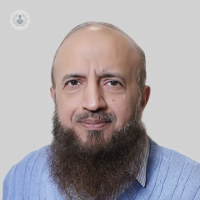How does laser therapy treat prostate enlargement?
Written in association with:As a man ages, he may notice issues with passing urine. A blockage is likely to be caused by an enlarged prostate, a common symptom of aging. Mr Aasem Chaudry, an esteemed consultant urologist based in Bedford, shares his expertise on how prostate enlargement can be treated with laser, outlining the main side effects and how effective it is. He also explains whether laser treatment can be used to treat prostate cancer.

What does laser therapy for prostate disease entail exactly?
After the age of fifty, men will generally start to get some symptoms related to their water worlds, such as frequent urges to urinate or the inability to empty their bladder. As men get older, these symptoms tend to get worse and this is caused by the prostate which slowly enlarges as a part of aging. The majority of men, about 70%, will be affected by the time they reach 80 years of age. Lasers are a useful, safe, minimally invasive technique that removes the excess tissue in the prostate when necessary.
What are the main associated side effects?
Laser energy produces high temperatures at a targeted site. When we use this to treat the prostate, there are two types of lasers that are used; green light laser and Holmium laser (HoLEP). Both of these lasers function differently. The green light laser evaporates the prostate while the HoLEP acts as a knife that can cut very precisely without causing bleeding. Both use high temperatures at the sites of surgery so that the tissue can be removed in a non-traumatic manner.
However, there can be complications and side effects because of these thermal effects if they are transmitted beyond the intended area. These can cause some discomfort and pain in the postoperative period. Occasionally if the urethra, the tube which leads from the bladder out of the body, gets damaged during the procedure, it can cause narrowing or strictures. Infections are always a risk in the postoperative period, but antibiotics are given as a precautionary measure.
Overall, how effective is laser therapy for prostate disease? What are the general results?
We use these surgical techniques in patients with prostate enlargement if medical therapy has failed. In more than 50% of cases, patients will not require surgical intervention. In the remainder of cases that require surgical intervention, laser therapy treatment is the best option available to remove the obstructing part of the prostate.
In terms of the actual procedure, it is performed under anaesthetic. A special piece of equipment is used to see the prostate directly and guide the laser through during the operation, so the surgeon can see what they are doing.
Does laser therapy have any role in treating prostate cancer?
The laser is used, in theory, to relieve obstruction. A simple analogy is to think of the prostate like an orange; when we perform surgical treatments for benign prostatic diseases, including laser treatments, we remove the pulp of the orange and leave the peel behind. In prostate cancer, the cancerous cells tend to be in the peripheral part or the peel of the orange. So, although laser techniques can be used to relieve the symptoms in prostate cancer patients, such as an obstruction or interference with the urine flow, it is not a treatment for cancer.
Mr Aasem Chaudry is a consultant urologist, treating patients in Bedford. If you would like to book a consultation with him, you can do so visiting his Top Doctors profile today.


